Nof S.Y. Springer Handbook of Automation
Подождите немного. Документ загружается.


Automation in Agriculture 63.3 Greenhouse Automation 1105
modern greenhouse operations that include control of
climate, irrigation, and nutrient supply to plants to
produce the best conditions for crop growth in an eco-
nomical way. Environmental control enables year-round
culture and shorter cultivation periods. This section out-
lines greenhouse environment control and automation.
Parameters and Sensors
for Environmental Control
Light. Generally, there are two types of light: sun-
light and artificial light from lamps. Visible light
(400–700 nm, photosynthetically active radiation) is
important for plant growth. Photosynthetic photon flux
density (PPFD, measured in μmolm
−2
s
−1
) from pho-
ton sensors is appropriate when light intensity is meas-
ured for plant growth, while intensity of illumination
(lux) is measured based on human sensitivity [63.77].
Although intensity and color temperature of sunlight
vary from time to time and from place to place, artifi-
cial lighting devices can change them more drastically.
There are several popular lighting devices: incandescent
lamp, fluorescent lamp, high-intensity discharge lamp
(HID lamp: Hg lamp, Na lamp, metal harido lamp),
light-emitting diodes (LED), electroluminescence (EL),
hybrid electrode fluorescent lamp (HEFL), and others.
It is necessary to use them based on size, shape, effi-
ciency, light intensity, life, color rendering, and color
temperature of the lamp [63.78].
Temperature and Humidity. Heating and cooling in
greenhouse are important for plant growth. Due to the
amount of energy consumed for these operations, their
control is critical. Electric heaters are used when it
is necessary to specifically heat local sections such as
in seedling production. Radiation in greenhouses that
use sunlight can cause high air temperatures. Hence,
cooling is necessary. To reduce cooling costs, curtain,
infrared absorption glass (80% transmittance in visi-
ble region and 20% in infrared region), watering on
glass roof, whitening the cover material, fan and pad
system, fan and mist system, fog and fan system, and
other methods are employed [63.79]. The thermocou-
ple sensor is a popular measure of air temperature,
while a thermo-camera and other radiation thermome-
ters can measure radiant energy from plant parts or
material bodies. Several types of humidity sensors are
available: elemental devices whose electrical resistance,
capacitance, or impedance is changed with humidity
change. The sensors can measure 10–90% relative hu-
midity. Humidity in greenhouses is influenced by air
temperature control, transpiration from plants, water
evaporation from soils, and other effects; for example,
the fog and fan system can decrease temperature by
2
◦
C and increase humidity by 20% as compared with
external air [63.80]. To reduce humidity, an electric
cooling machine is sometimes used, while air ventila-
tion is the simplest method. Thus, humidity control also
requires compensation of temperature change. When
greenhouse environments are controlled, both heat bal-
ance and moisture budget must be considered. PID and
adaptive control methods have been developed for tem-
perature and humidity control [63.81–83].
CO
2
Concentration. Plants absorb CO
2
and transform
it into sugars and then into new plant tissue [63.84].
Every gram of CO
2
fixated by the plant yields around
10g of new plant material. This so-called photosyn-
thesis (or CO
2
assimilation) requires good light and
suitable growing conditions.Plants consume more CO
2
under more light and also at higher CO
2
level. By CO
2
enrichment the CO
2
uptake can be increased. The effect
of CO
2
on yield is proportional to the amount of time of
CO
2
enrichment.
CO
2
uptake depends on the crop, the leaf area, and
environmental conditions such as soil moisture and at-
mospheric humidity. It is expressed in gram CO
2
gas
per m
2
ground area per hour (g m
−2
h
−1
). CO
2
up-
take varies from 0 during very poor conditions to about
5gm
−2
h
−1
under excellent light conditions, and up to
7gm
−2
h
−1
under excellent light conditions combined
with high CO
2
levels. At night no CO
2
is taken up; in
contrast, plants produce CO
2
due to respiration. Hence
the CO
2
level in a closedgreenhouse naturally increases
overnight to above-ambient levels.
Ventilation influences the CO
2
level, which has
three situations:
1. CO
2
depletion: the CO
2
level is below ambient.
Any leakage or ventilation will bring CO
2
into the
greenhouse. Ample ventilation can prevent CO
2
de-
pletion.
2. Elevated CO
2
levels due to CO
2
enrichment. CO
2
gas will rapidly be lost during venting, depending
on the vent opening, wind speed, and CO
2
level.
3. When theCO
2
level in the greenhouse isequal to the
level outside. The influx of fresh air plus the CO
2
supply exactly compensates the CO
2
absorption. In
this situation there is no CO
2
loss. The CO
2
demand
equals the CO
2
absorption by the plants plus the
CO
2
lost by leakage or ventilation.
Part G 63.3

1106 Part G Infrastructure and Service Automation
However, the benefits of CO
2
enrichment should
outweigh the costs. This depends on the yield increase
due to CO
2
, as well as on the price ofthe produce. Mod-
erate CO
2
enrichment is sometimes more economic
than excessive enrichment. CO
2
enrichment should not
go beyond 1000ppm, as it is notbeneficial for the plants
and is unnecessarily expensive.Sensitive plants (e.g.,
young or stressed plants, sensitive species) should not
be exposed to more than 700ppm CO
2
. Too high CO
2
levels cause partial closing of the pores in the leaves,
which leads to low growth. Also, at higher CO
2
concen-
tration, there is higher risk of accumulation of noxious
gases that can be present in the CO
2
gas.
Air Flow. It is important to keep uniform temperature,
humidity, and CO
2
in the greenhouse for proper plant
culture and uniform growth. Air flow in greenhouses is
achieved in different ways depending on the greenhouse
structure. Natural ventilation is usually used due to its
low costs. However, control of airflow with natural ven-
tilation is limited. Therefore, it is necessary to analyze
natural ventilation properly and increase ventilation
efficiency. Natural ventilation is driven by pressure dif-
ferences created at the vent openings both by wind
and/or temperature differences. Prediction of air ex-
change rates and optimization of greenhouse design
requires complicated models due to the coupling and
nonlinearities in the energy balance models. Additional
controls of air flow include on/off control of fan ventila-
tion systems, side openings, and water sprayers [63.85]
with recent developments in rate control achieved by
PID or fuzzy-logic control.
Control Methods
Greenhouse climate control requires consideration of
many nonlinear interrelated variables. Control models
should take into account weather prediction models,
crop growth models, and the greenhouse model. The
following methods have been used for control: clas-
sical methods (proportional integral derivative control,
cascade control), advanced control (nonlinear, predic-
tive, adaptive [63.86]), and artificial intelligence soft-
computing techniques (fuzzy control, neural networks,
genetic algorithms [63.87,88]). Control is implemented
with programmable logic controllers or microcomput-
ers. Climatecontrollers that use online measurements of
plant temperature, and fruit growth and quality, to esti-
mate actual transpiration and photosynthesis will be the
future development. This will enable the development
of closed-loop systems that use the speaking plant as
the feedback for the control system and thereby result in
effective control of the greenhouse climate [63.89,90].
Effective control of the greenhouse climate must also
incorporate long-term management plans to increase
profitability and quality [63.91].
63.3.2 Seedling Production
Seedling production is one of the key technologies to
grow high-quality products in fruit and vegetable pro-
duction. Seedling operations such as seed selecting,
seeding, irrigating, transplanting, grafting, cutting, and
sticking have been mechanized or automated [63.77].
A fully automatic seedling production factory has been
reported as a part of a plant factory [63.78], while
a precise seeding machine which can seed in the same
orientation has also been developed [63.79]. Several
grafting robots and robots for transplantation from cell
tray to cell tray or to pot have been commercialized.
Herein, a grafting robot and a cutting sticking robot will
be described as examples.
Grafting Robot
Grafting operations are conducted for better disease
resistance, higher yield, and higher-quality products.
Opportunities for the grafting operation are recently
increasing, because of the agricultural chemical restric-
tions introduced to improve food safety and sustainable
agriculture in the world. As the demand for grafted
seedlings increases, a higher-performance model or
a fullyautomatic model of the grafting robot is currently
expected, while semiautomatic models have been com-
mercialized since about 20 years ago. Grafting involves
the formation of one seedling by uniting two different
kinds of seedlings, using the side of the root of one
seedling and the side of the seed leaf of the other. The
side of the root of a seedling is called a stock and the
side of the seed leaf, a scion. In order to graft a wa-
termelon or a cucumber, a pumpkin is frequently used
as a stock. The grafting method shown in Fig.63.10
is called the single cotyledon grafting method,andis
adopted as the operation process of a grafting robot for
cucurbitaceous vegetables. For the stock, one seed leaf
and its growing point are cut off. For the scion, the side
of the root side is cut off diagonally at the middle of the
hypocotyl, and the side of the seed leaf which contains
the growing point is used.
Grafting operation of different kinds of plants is
carried out by joining the stock and the scion using
a special clip as an adhesive. Although stock seedlings
and scion seedlings are hung up on spinning discs and
supplied synchronously in some robot, mechanical fin-
Part G 63.3
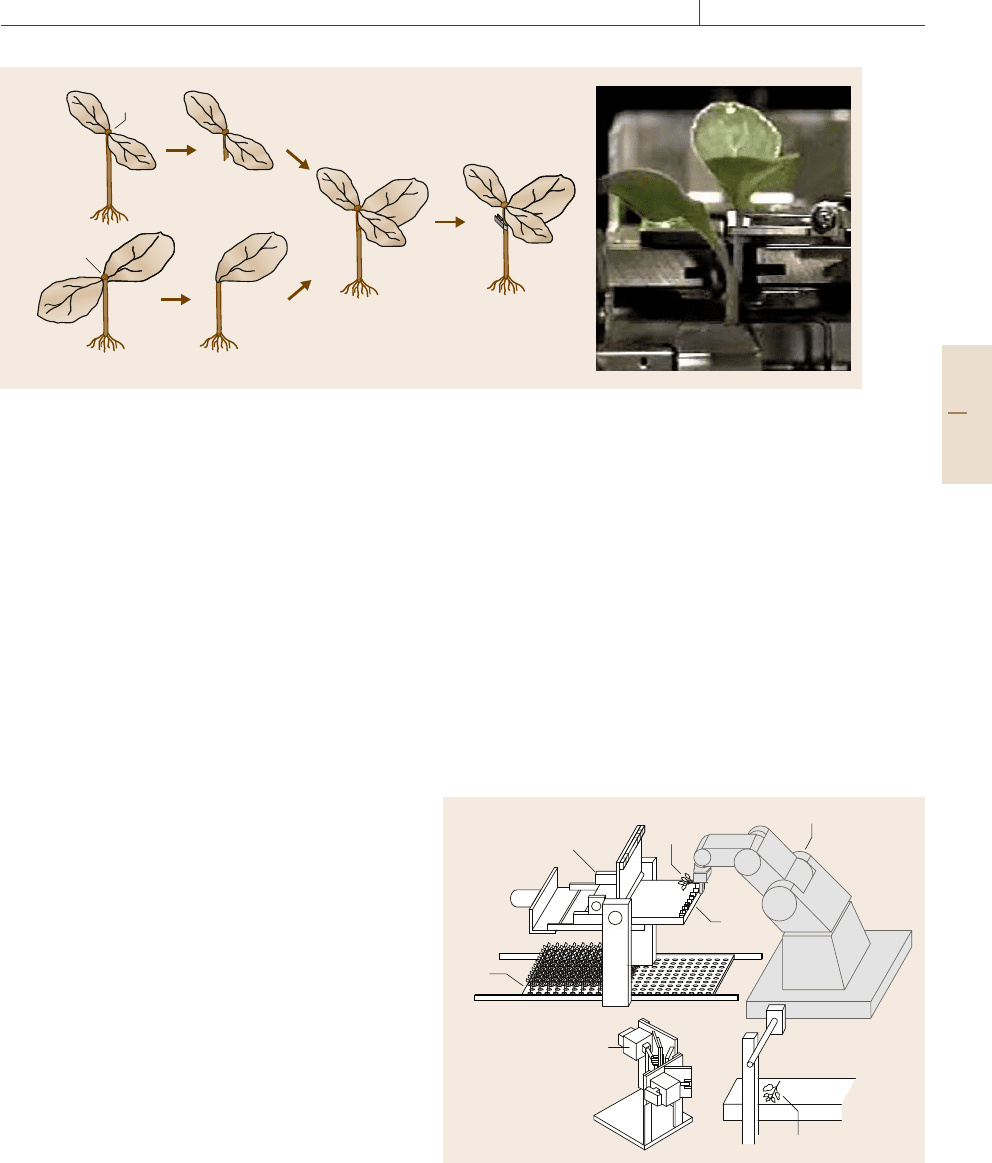
Automation in Agriculture 63.3 Greenhouse Automation 1107
Growth
point
Growth point
Scion
Seedling Cutting
Rootstock
Put together Clipping
Grafting
Scion
Stock
Fig. 63.10 Single cotyledon grafting method and an actual grafted seedling with mechanical fingers in the grafting
operation of a robot (after [63.84,89])
gers handle the seedlings, as shown in Fig. 63.10.Two
operators hand the stock and scion to the mechanical
fingers individually. At the stock cutting section, the
shoot apex which contains one of the seed leaves and
growing points are cut off by a spinning cutter which
spins in the diagonally upward direction. On the other
hand, at the scion cutting section, the side of the root is
cut off at the hypocotyl by a spinning cutter which spins
in the diagonally downward direction. After removing
the useless part, the stock and the scion are gripped by
the gripper and sent to the clipping section, where they
are joined and fixed by the clip. The most important
points in grafting operations are to cut the seedlings at
the proper points and fix the stocks and scions precisely.
To accomplish a higher success rate, the stock and scion
should be properly hung for the spinning cutters when
seedlings are handed into the mechanical fingers. The
success rate of the grafting robot is 97% and the robot
can perform grafting operations ten times faster than
human workers [63.77].
Cutting Sticking Robot
Cutting sticking operations are often conducted in
flower production in order to enhance productivity by
using cuttings obtained from mother plants. Currently,
humans manually stick the cuttings, however, the oper-
ation is monotonous and requires a lot of time andlabor.
A semiautomatic and a fully automatic chrysanthemum
cutting sticking systems [63.80, 81] have been devel-
oped so far. In this section, a fully automatic system
for chrysanthemum will be introduced, because it has
a function of recognizing complicated-shaped seedlings
by machine vision.
Robotic Cutting Sticking System. A prototype robotic
cutting sticking system (Fig.63.11) mainly consists
of a cutting-provision system, machine vision, a leaf-
removing device, and a planting device. The figure
includes the latter three sections. The flow of cutting
sticking operation is as follows: first, a bundle of cut-
tings is put into a water tank for refreshment because
the cuttings are usually stored in a refrigerator for about
a week until some amount of cuttings need to be pre-
pared through picking from mother plants. The cuttings
are floated on the water and spread out by adding vi-
brations to the tank. After refreshment in water and
spread enough in a while, the cuttings are picked up
by a manipulator based on information about the cut-
Holding plate
Cutting
Manipulator
Table
Tray
TV camera
Cutting
Leaf removing
device
Planting device
Fig. 63.11 Chrysanthemum cutting sticking system (prototype)
Part G 63.3
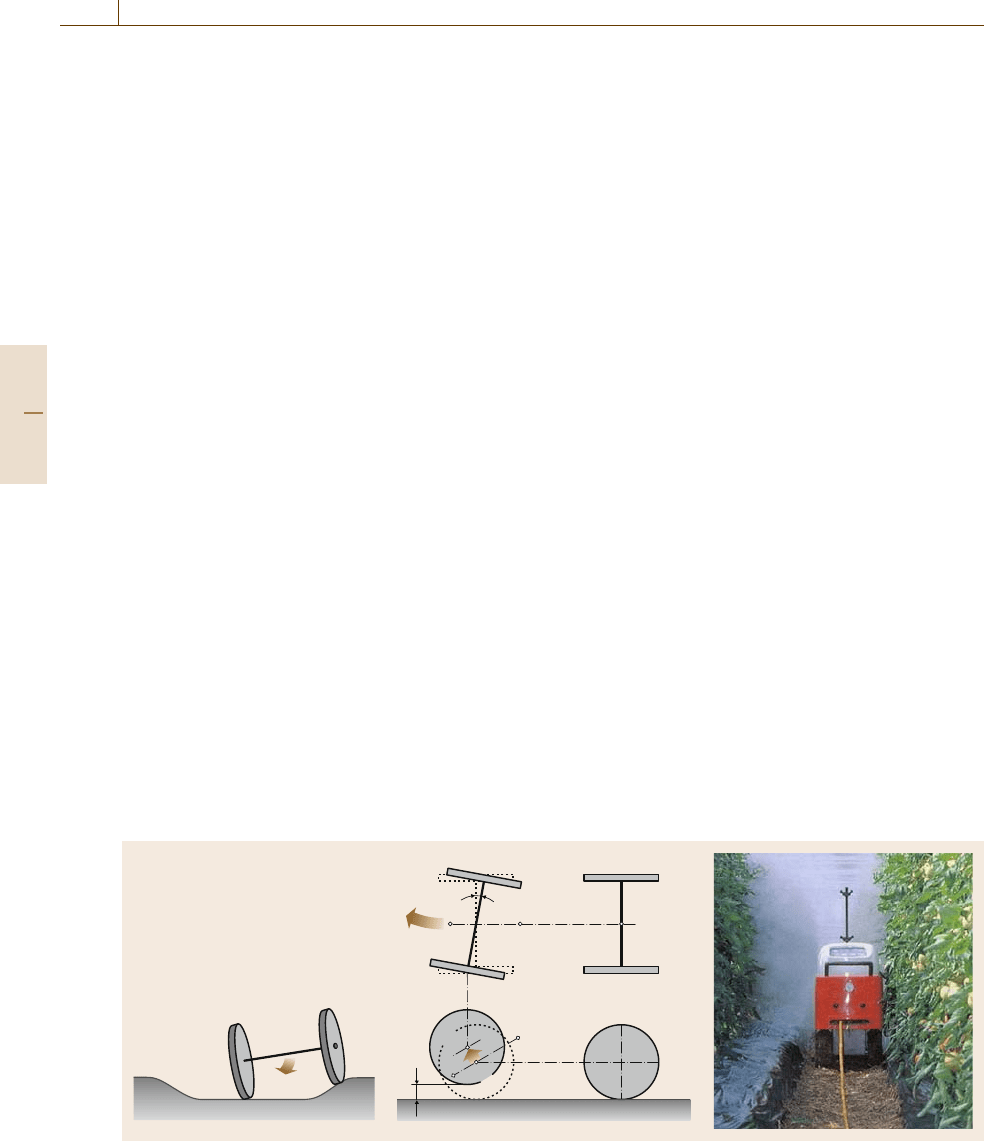
1108 Part G Infrastructure and Service Automation
tings – positions and orientations from a television (TV)
camera installed above the water tank.
Secondly, another TV camera (Fig. 63.11) detects
the position and orientation of the cutting, which is
transferred toa table from the water tank by the manipu-
lator. The TV camera indicates the grasping position of
the cutting foranother manipulator,shownin Fig.63.11.
Thirdly, the manipulator brings the cutting to the plant-
ing device via the leaf-removing device. Finally, the
cuttings are stuck intoa plugtray bythe plantingdevice.
The leaf-removing device consists of a frame with
cutters, a movable plate with rubber, and a solenoid ac-
tuator. The movable plate is driven to open and close by
the solenoid actuator in order to cut lower leaves and ar-
range the shape of upper large leaves by chopping them
with the cutters. Two identical devices are placed at an
angle of 90
◦
to cut the leaves completely since each leaf
emerges at an angle of 144
◦
from the main stem. Parts
of the upper large leaves and lower petioles are cut by
closing the movable plate. After this operation at the
first device, the cuttings are moved to the second device
and other leaves desired for removal are cut.
The planting device mainly consists of a table to
place the cuttings in a row and a holding plate which
opens and closes. The holding plate is driven to open
and close by a motor which is mounted on the table.
The table and the plate are driven in linear motion by
another motor and a screw, and are rotated by a mo-
tor. A cell tray is set below the planting device. The
holding plate closes after ten cuttings are placed on
the table since a row of the tray has ten cells. The
table rotates until it is perpendicular to the tray and
moves downward. The ten cuttings are stuck into the
tray together and the planting device adopts the ini-
H
a
β
ab
b
O
2
O
1
Rear axleFront axle
Fig. 63.12 Self-heading-correction mechanism and an unmanned sprayer (courtesy of Maruyama MFg., Co. Inc.) (af-
ter [63.84,89])
tial position after the holding plate opens and the table
moves upward.
Machine Vision. To pick up and transfer the cuttings,
detection of the grasping point of the cutting is re-
quired. A monochrome TV camera whose sensitivity
ranges from the visible to infrared regions was used
with a 850 nm interference optical filter to enhance the
contrast of the cutting on a black conveyor. The algo-
rithm to detect the grasping point [63.82]isasfollows:
the complexity of the boundary line of the cutting on
a binary image is investigated and candidate points of
the stem tip are found. If only one candidate point is
found in the image, the point is determined as a stem
tip. When there are more than two candidate points, the
complexity of the boundary line around the candidate
points is detailed and points which are not adapted to
conditions of the main stem are removed. The condi-
tion is that boundary lines around the stem tip have a lot
of linearity. If only one candidate point remains after
processing, the point is determined as the stem tip. In
the case of plural points remaining, the whole bound-
ary line of the cutting is detailed, the region of leaves is
detected, and a candidate point which has a certain dis-
tance from the region of leaves is determined as thestem
tip. When no point meets this condition or when more
than two points remain even after the processing, the
cutting is transferred back to the first stage, because it
is too risky to determine the stem tip in these cases. The
grasping point was defined as the position 10mm above
the stem tip. Experimental results indicated that about
95% cuttings are satisfactorily detected with no missed
detection, and all remaining cuttings were transferred
back.
Part G 63.3
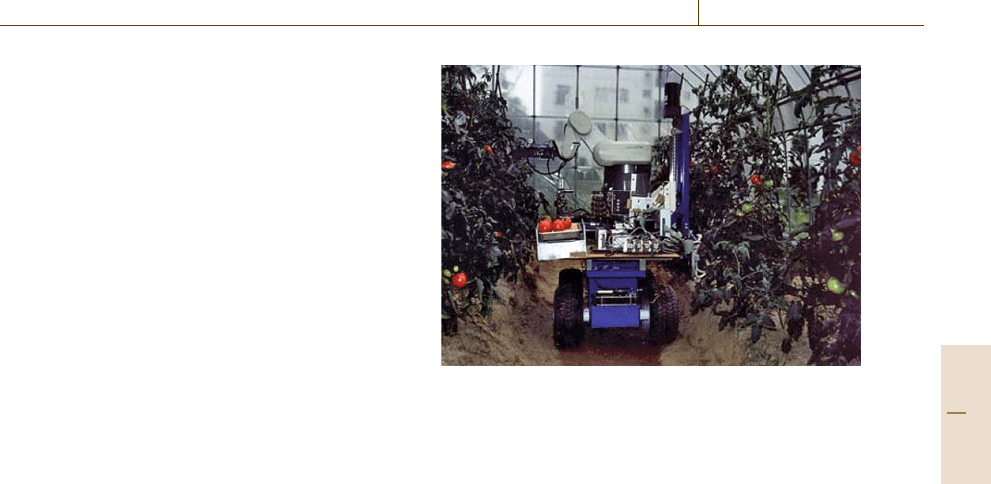
Automation in Agriculture 63.3 Greenhouse Automation 1109
63.3.3 Automatic Sprayers
Chemical control is required for crop production in con-
trolled environments, and automation of the chemical
spray is desirable to minimize exposure of chemi-
cals. Spraying robots have been commercialized so
far [63.83, 92, 93]. A key technology of the robots is
autonomous control of the vehicle. Figure 63.12 shows
the principle of the self-heading-correction mechanism.
The front axle can be turned freely around an axis A–B
which is fixed to the body diagonally. Assuming that
a front wheel on one side runs on a ridge (it is off
course), the center of this front wheel shifts from O1 to
O2. Atthe sametime, the other front wheel moves down
and back. Consequently, the resulting steering angle β
causes the vehicle to descend from the ridge, correcting
its moving direction by itself. In the case where both
a front and a rear wheel run on a ridge at the same time,
the effect of the heading correction will be reduced be-
cause the steering angle β may be smaller. To obtain
an appropriate steering angle, the rear tread is 35mm
shorter than the front tread. An unmanned sprayer is
showninFig.63.12.
Another method is called electromagnetic induc-
tion type. Induction wires are laid down under ridge
aisles and/or headland and a vehicle with an induc-
tion sensor detecting the magnetic field created by the
wires can automatically travel along the wires. When
the vehicles move to the next ridge aisle in narrow
headlands in greenhouses, several methods have been
reported: a pivot shaft that comes out to make the
turn, four-wheel steering, an additional rail system to
convey the vehicle to the next aisle, and a manual
method. In orchards, automatic speed sprayers using
induction wires and induction pipes were developed
in 1993 and 1994, respectively. A method that uses
a remote-controlled helicopter has been very popular in
the fields.
63.3.4 Fruit Harvesting Robots
It can be said that the history of agricultural robots
started with a tomato harvesting robot [63.94]. There
has been much research on fruit harvesting robots for
tomato, cherry tomato, cucumber, eggplant, and straw-
berry [63.95–100]. Vegetable harvesting robots have
also been investigated, but there is no commercial robot
yet. The main reasons limiting commercialization of
harvesting robots are low success rates due to diver-
sity of plant properties, slow operational speeds, and
high costs associated with the seasonal affect. How-
Fig. 63.13 A tomato harvesting robot
ever, practical use of harvesting robots is expected in
the future.
Tomato Harvesting Robot
Research on the first tomato harvesting robot started at
Kyoto University in 1982 and several different types
of tomato harvesting robots and their components have
been developed. A cluster harvesting robot is now un-
der development. The main components of many of
the tomato harvesting robots are a manipulator, end-
effector, machine vision, and traveling device, as shown
in Fig.63.13. The robot automatically travels between
ridges and stops in front of a plant using photosensors
and reflection plates on the ridges, which can give the
location of the robot in the greenhouse. When the trav-
eling device stops, a machine-vision system measures
fruit color and location, the manipulator approaches the
cluster, and an end-effector picks a fruit. After complet-
ing the operation at the location, the robot moves to the
next location of the reflection plate.
Phytological Characteristics of Tomato Plant
Most tomato plants for the fresh market are usually
grown on a vertical plane with supports or with hang-
ing equipments until many fruit clusters are harvested.
However, high-density single-truss tomato production
systems (STTPS) have been reported [63.101]. In ad-
dition, an attempt was conducted to grow the tomato
plant upside down on the tomato production system be-
cause of the smaller labor requirement for plant training
and ease of mechanical operation.Some varieties are for
individual harvesting while others are for cluster har-
vesting.Some varieties produce round-shapedfruits and
longer fruits, depending on the season. There are also
many fruit sizes. Fruit clusters are supposed to grow
Part G 63.3
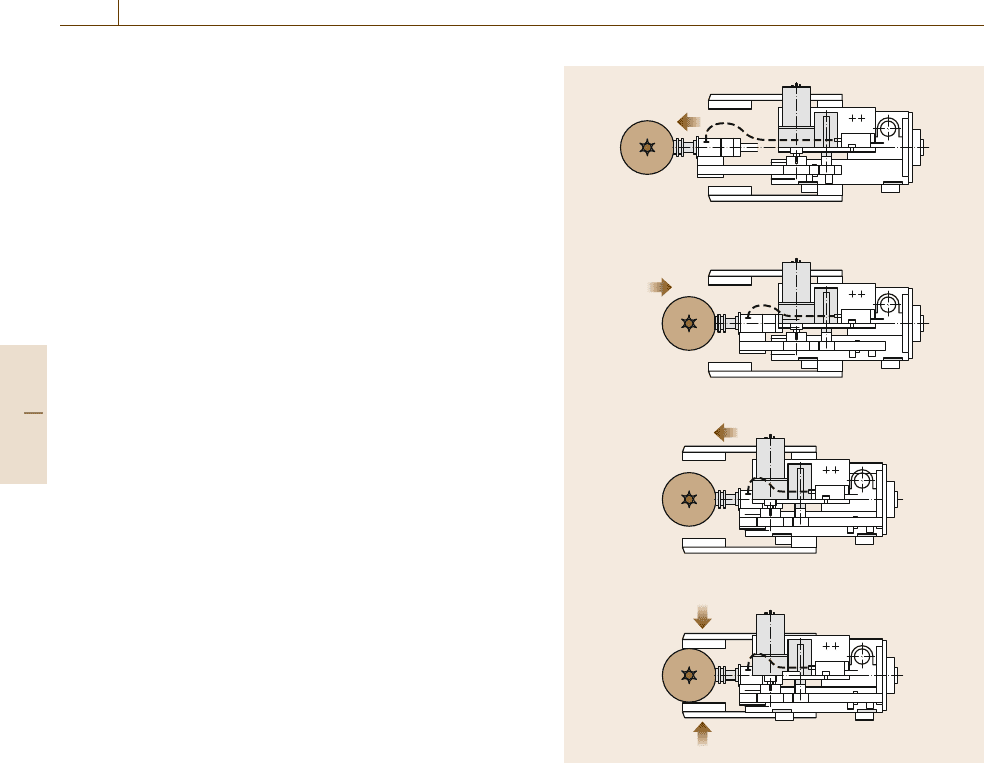
1110 Part G Infrastructure and Service Automation
outwards due to a growth rule, but the main stem some-
times twists, which causes random cluster direction so
that tomato fruits may sometimes be hidden by leaves
and stems. When a robot is introduced to the production
system, it should be adaptable to plant diversity.
Manipulator
The basic mechanism of a manipulator depends on the
configuration of the plant, the three-dimensional (3-D)
positions of its work objects, and the approach paths to
the objects. In the first attempt to robotize the tomato
harvesting operation, a five-degree-of-freedom (DOF)
articulated manipulator was used [63.98], and a seven-
DOF manipulator was investigated for harvesting six
clusters [63.102]. However, the Dutch-style growing
system has been popularly introduced to large-scale
greenhouses throughout the world, and target fruit are
always located at a similar height. Therefore, a selective
compliant robot arm (SCARA)-type manipulator can be
used. When the fruit cluster is transferred to a container
quickly, cluster swing damping is required.
End-Effector
The fruit cluster has several fruits and their peduncles
have joints in many varieties of tomato plants. When
a human harvests ripe fruit one by one in the clus-
ter, he/she can pick them off easily by bending them
at the joints instead of cutting. To harvest the fruit,
several end-effectors have been developed; Fig.63.14
shows one of them [63.103]. A 10mm-thick rubber pad
is attached to each finger plate to protect the fruit from
slipping and damage. The length, width, and thickness
of a finger plate are 155, 45, and 10mm, respectively.
The gripping force exerted by the finger plates can be
adjusted from 0 to 33.3N, while these finger plates
grip fruits ranging from 50 to 90mm in diameter. The
suction pad was attached to the end of a rack, which
is driven back and forth by a DC motor and a pin-
ion between the finger plates. The speed and stroke
of the suction pad motion are 38mm/s and 80mm,
respectively. The suction pad can be moved forward
up to 43mm from the tips of the finger plates. The
moving distance and stopping position of the pad can
be detected by a rotary-type potentiometer. Two limit
switches are attached to both ends of the pad stroke in
order to prevent the pad from overrunning.
Machine Vision
A traditionalmethod of detecting 3-D locations oftarget
fruits is feature-based stereo vision. A pair of iden-
tical color cameras acquire images and discriminate
Fig. 63.14 An end-effector
red-colored fruits. Based on the disparity of fruits on
both images, the depth of the target fruit can be calcu-
lated. Although a small error in the 3-D location occurs
because of hidden parts of the fruits, the suction pad can
tolerate these error. It is not easy for stereo vision to de-
tect all fruits locations when a corresponding problem
happens due to hidden fruits and many fruits in the im-
ages. In this case, a 3-D lasersensor orarea-based stereo
vision may help detect the fruit depths.
Traveling Device
Figure 63.13 shows a four-wheel-type battery car on
which a tomato harvesting robot is mounted. The travel-
ing device moves andstops between the ridges and turns
at the headlands to go to another ridge. In Dutch-style
large-scale greenhouses, two heating pipes are usually
used. It is easy to introduce a rail-type traveling device
Part G 63.3

Automation in Agriculture 63.4 Animal Automation Systems 1111
as these pipes can be used as rails. Rail-type travel-
ing devices (manual or self-propelled) are already used
for leaf picking, manual harvesting, spraying, and many
other operations in greenhouses.
63.4 Animal Automation Systems
Automation of animal husbandry systems includes
the development of environmental control systems,
automated weighing and monitoring systems, and au-
tomated feeding systems.
Climate control of housed animals has an important
influence on the productivity and health of the animals
and therefore its control is very important [63.104].
However, this is a difficult and complicated task due to
the nonlinear effects of the animals on the temperature
and humidity conditions inside animal housing build-
ings [63.104]. In conditions where animals are housed
outside, control is further complicated due to changing
environmental conditions. Air-quality and environmen-
tal monitoringis importantfor environmental protection
aspects and hence is gaining increasing attention and
importance.
Devices for electronic animal identification and
monitoring became available in the mid 1970s and
have enabled implementation of advanced management
schemes [63.105], specifically for livestock and swine
management. The ISO standardization of injectable
electronic transponders in the late 1990s expanded
applications to all animal species [63.105]. Several sen-
sors have been developed to provide individual animal
parameters such as size, weight, and fat. These param-
eters are used for management decisions. The current
new generation of sensors enable health and produc-
tion status monitoring, both improving animal welfare
and ensuring increased food quality and safety. Re-
cent developments include acoustic passive integrated
transponder tags using micro-electromechanical sys-
tems (MEMS) technology [63.106]. Tags may be used
for tracing animals from growth to final processing for
quality control and food security purposes [63.106].
The main expense in animal production systems
is food intake. Automated feeding systems decrease
production costs while ensuring that animals receive
necessary nutrient ingredients. Group and individual
feeding systems have been developed to measure and
control food intake.
Production, health, and welfare controls are being
introduced into modern farms using advanced infor-
mation systems. Data from multiple sensors at the
individual and group levels are taken on a daily basis
for advanced monitoring and control. Various systems
will be presented in the following sections.
63.4.1 Dairy
The dairy industry is probably the most automated agri-
cultural production system, with almost all processes,
from feeding to milking, being completely automated.
In the dairy industry, many maintenance routines such
as milking, feeding, weighing, and online recording
of performance are fully automated on an individual
animal basis. Optimal management is defined as pro-
ducing maximum milk yield while minimizing costs.
The computation and data-storage capacity of comput-
ers theoretically enable sophisticated decision-making
to underpin the automated processes in order to ob-
tain optimal individual and herd performance. These
include automated feeders, sensors that measure daily
activities of cows, and online automated parlor systems
for recording milkproduction and quality. Reproduction
monitoring includes systems for timing of insemination
based on oestrus detection. Health care systems include
detection of mastitis. The objective is to fully automate
every processfrom feedingto milkingto reduce produc-
tion costs and maximize milk yield.
The physical process of feeding and recording ac-
tual feed consumption is based on feed administration
of concentrates and roughage, ration composition, and
feed calculation for an individual cow or a group of
cows. Analysis of performance data indicates that cow
performance under a uniform rationing regime is con-
sistent in trend but varies in magnitude, and therefore
an optimal feed policy, in terms of efficient rationing of
concentrates, should be on an individual basis [63.107].
An alternative approach, the sweeping method, is based
on average values for the herd. This can cause cows
not to reach maximum milk yield because of insuffi-
cient concentrate ration or imply that excess feed be
consumed since there are cows that would have reached
their maximum milk yield with a smaller concentrate
ration. Both result in redundant financial expense. Due
to the advent of technology, the farmer is able to
allocate a different amount to each cow using indi-
vidual computer-controlled calf feeders [63.108]and
Part G 63.4
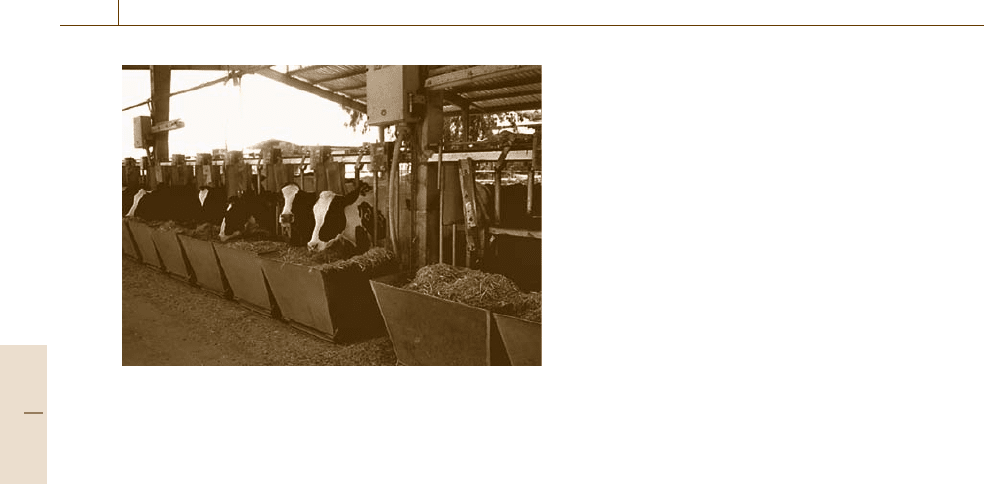
1112 Part G Infrastructure and Service Automation
Fig. 63.15 A controlledautomatic fodderconsumption and
feeding system (after [63.109])
integrated real-time control systems for measuring,
controlling, and monitoring individual food intake of
free-housed dairy cows [63.109]. Individual allocation
decisions are made according to each cow’s perfor-
mance, Performance parameters include the individual
cow’s output (milk yield and composition) and mea-
surements of physiological variables including body
composition [63.110], shape, and size. An example of
a system consisting of 40 feeding cells is shown in
Fig.63.15. Each cell comprises an identification sys-
tem, a fodder weight system, and an automatic opening
and closing yoke gate [63.109]. Each feeding stall con-
sists of a feeding trough, an electronic weight scale
and central processing unit (CPU), identification sys-
tem, presence sensor, and a cylinder with valve. All
components are connected to a programmable logic
controller (PLC) which processes the data and acti-
vatesthe electropneumatic actuators. The data is backed
up to a management computer. The management com-
puter is also used as a monitoring station and a basic
man–machine interface for defining basic operations
and preliminary data analysis. The specific yoke design
allows the cow’s head to enter the yoke gate without
enabling access to the fodder. This places the radiofre-
quency identification tag on the cow’s ear close enough
to the antenna and simultaneously activates the proxim-
ity sensor (by the cow’s head). If the cow is allowed
to eat according to the predetermined conditions, the
PLC records the current scale’s weight and the yoke
gate bar is lowered by the associated electropneumatic
cylinder. The cow may then push its head into the fod-
der trough and feed. The scale measures and records
the weight of the fodder at predefined intervals. Each
CPU scale is connected to the PLC directly via bi-
nary code to decimal (BCD) so no time delay is caused
by weight transmission. A restriction bar on the fod-
der trough prevents the cow from pushing its head up,
thereby preventing spillage of fodder. The use of pres-
ence sensors in the yoke appeared to be very important
to determine if the cow had left the yoke station. The
feeding troughs were arranged in a row to enable con-
venient dispersal of fodder (into the containers) by the
passage of a semiautomated fodder dispersal wagon.
Several methods have been developed for automatic
weighing of cows. Cows are weighted as they exit the
milking parlor so as not to interrupt their daily regime.
The motion of cows creates measurement problems, in-
cluding changes along the scale due to applied forces,
crowding of cows on the scales, and significant vari-
ations between cows and between the same cow at
different times of the day or on different days. Dynamic
weighing of cows is a common practice in many com-
mercial farms, achieved by filtering the measured signal
and averaging it or recording the peak value as the cow
transfers its weight [63.111–113] using physical math-
ematical models that simulate cow walking [63.114].
Milking cows is a complicated task due to the
physics combined (teat treatment, control of the milk-
ing unit) and variable biological components (milk
secretion, udder stimulation) including the risk of in-
fecting the udder with pathogen microbes [63.115].
Although the first proposals for mechanical milking
were presented over 100years ago, milking machinery
became common only in the early 1950s, with com-
pletely automatic milking systems being introduced in
the 1990s [63.116]).
First steps in automating the milking process in-
cluded detection of end of milking and automatic teat
cup detaching [63.115]. Various optical, capacitive, and
inductive sensors were developed to detect low milk
flow, which indicated end of milking [63.117]. Mech-
anized stimulation of udder was achieved by using
pneumatic and electronicpulsators. Continuous individ-
ual variation of vacuum level, pulse rate, and pulse rate
for each milking unit was developed. Milk yield record-
ing is implemented using tipping trays and volumetric
measuring systems, with many sophisticated measuring
systems to separate air from milk to improve accuracy.
Automatic milking requires automatic application of
teat cups. Ultrasonic sensors, a charge-coupled device
(CCD) camera, and a laser are used to locate the teats
to control in real time the arm to adapt to the varia-
tions in teat positions, spacings, and shape and to the
motions of the cow during teat attachment. In most sys-
tems a two-stage teat location process has been applied.
Part G 63.4

Automation in Agriculture 63.4 Animal Automation Systems 1113
First, the approximate teat positions are determined by
dead reckoning using body position sensors, ultrasonic
proximity sensors or vision systems. The final attach-
ment is achieved by fine-position sensors using arrays
of light beams mounted on the robot arm. Automatic
checks of udder condition and milk quality include on-
line milk analysis. Milk quality is a critical parameter
both from an economic point of view and from health
perspectives [63.116]. Measures include conductivity,
temperature, and color of milk, integrated with yield
information. Biosensors have been used to measure an-
tibiotic residues, mammary infection components, and
metabolites including the development of electronic
samplers that enable real-time measurements [63.118].
Online inline milk composition sensors measure in real
time during milking the concentrations of fat, protein,
and lactose, and indicate the presence of blood and
somatic cell count (SCC) based on near-infrared ana-
lysis [63.119].
Various teat cleaning systems, including brushes
and rollers or separate teat-cup-like cleaning devices,
have been developed. In addition, systems for clean-
ing the complete system (circulation cleaning, cleaning
with boiling water, cluster flushing [63.116]) are ap-
plied.
Robot milking (see Fig. 63.16 for an example), in-
troduced in the early 1990s by several commercial
companies (e.g., Lely, DeLaval, GM Zenith, Fullwood
Merlin), provides increased yield by increasing the fre-
quency of milking and improved milk quality.
Automatic health measurements during automatic
milking include leg health measurement and respira-
tion rate measurement [63.120]. Lameness detection is
important due to the important welfare, health, and eco-
Fig. 63.16 Lely milking robot in an open barn with fans
controlled when cow crowding is detected
nomic problems it causes. Leg health is also measured
by measuring the dynamic weight or load of each leg
while the cows are weighed on scales at the exit of the
milking parlor. Several techniques have been developed
including pedometers, activity meters worn around the
neck, force plates that measure reaction forces on
walk-through weighing systems [63.120–123], and in-
creased respiration rate measured using laser distance
sensor [63.120]. Ultrasonic back-fat sensor can provide
information about the health or growth status of the
livestock [63.124].
Another important health measure is mastitis,
a main reason for reduced milk yield and early losses
in cows, caused by the biological activity of microbes.
It can be detected by counting the number of somatic
cells in milk. Various methods have been developed
to measure it accurately using electrical conductivity
measurements, body temperature, and milk tempera-
ture. Recently inline near-infrared sensors have been
developed to measure milk conductivity and milk tem-
perature of each seperate quarter (a sensor is connected
to each udder cup) [63.119].
The primary direct parameter to detect oestrus is
concentration of milk hormones (progesterone), indi-
cating the fertility status of the cow. However, it is
commonly measured only in laboratories based on
samples, although biosensors have been developed for
its measurement [63.125]. Several indirect parameters
have been developed into automated systems, includ-
ing electrical conductivity of vaginal secretion, milk
temperature, and cow behavior including cow activ-
ity measurement using pedometers, heart rate, etc.
Improved measurement was achieved by combining in-
formation from severalparameters (e.g.,combining cow
activity with milk yield, feed intake, milk temperature).
Behavior measurement has been achieved using dif-
ferent systems: a radar-based automatic local position
measurement system for tracking dairy cows in free
stall barns [63.126],global positioningsystems for mea-
suring grazing behavior (Turner et al. [63.127], video
measurements [63.128], and automatic tracking sys-
tems based on magnetic induction [63.129].
Environmental control systems in the dairy industry
are less common since cows are located in barns that
are open, shaded or partially shaded. Systemsdeveloped
include automatic cooling using fans based on online
imaging systems that detect crowding (Fig.63.16)and
microclimate and gas emissions in cold uninsulated cat-
tle houses [63.130].
Management information systems that combine
herd and individual health and production param-
Part G 63.4
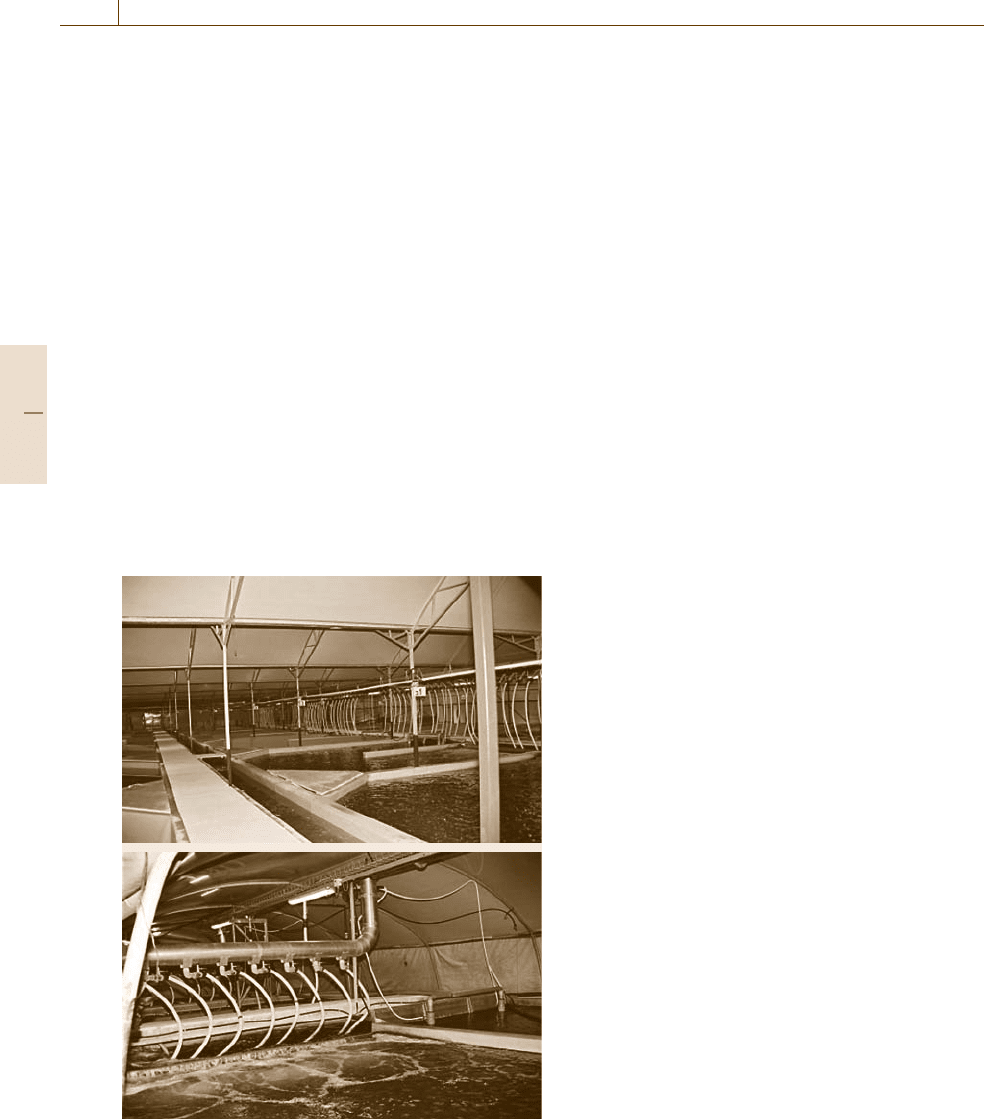
1114 Part G Infrastructure and Service Automation
eters [63.131,132] are important to ensure efficient au-
tomation. Further advances in design and management
of livestock environments will require development
of sustainable livestock production systems account-
ing systematically for the environmental benefits and
burdens of the processes using a lifecycle assessment
process [63.133]. Strategies will need to be developed
to regulate and reduce harmful gas emissions from live-
stock farms and land application of manure [63.134].
63.4.2 Aquaculture
Physiological rates of cultured species can be regulated
by controlling the environmental conditions and system
inputs. This yields increased process efficiency, re-
duced energy and water losses, reduced labor costs, and
reduced stress and disease. Automation applications in-
clude algae and feed production, feed management,
environmental controls such as filtration systems, and
automated air-pressure control. An intensive water-
quality monitoring program includes routine sampling
(twice a week) and 24h sampling (every 3months) of
Fig. 63.17 Water channels and air distribution system. Air-
flow rate is controlled by regulating air-blower frequency
using readings of oxygen concentration in the fish tank
nitrogen (NO
3
,NO
2
), phosphate, pH, and temperature.
Fish and shellfish biomass should be sampled and sea-
weed should be harvested [63.135,136].
Automation usually exists in closed systems such
as recirculated aquaculture systems, but it can also
be applied to pond and offshore aquaculture systems.
Intensive recirculating aquaculture systems (RAS) re-
duce land and water use at the expense of increased
energy requirements for operating treatment processes
to support high culture densities, often with the addi-
tion of pure oxygen (see, e.g., Fig.63.17). The use of
pure oxygen is usually expensive and requires consid-
erable energy for dissolving in the water as well as
for stripping off the carbon dioxide created by respi-
ration. In conventional RAS design gas exchange and
dissolved waste treatments (e.g., CO
2
stripping and
ammonia removal by nitrification) are linked into one
water-treatment loop. However, because excretion rates
of CO
2
are an order of magnitude greater than am-
monia excretion rates this design may result in toxic
CO
2
concentrations. In addition, pressurized pumping
and pure oxygen addition may increase the risk of
gas bubble disease. Hence, low-head recirculating sys-
tem that separate the gases treatment loop (oxygen and
CO
2
) from the nitrification and solid filtration treat-
ment loop by using a high-efficiency airlift producing
a bubbly flow are used [63.137]. The integrated pond
system (IPS) concept suggests a novel solution for en-
vironmentally friendly land-based mariculture. The IPS
recycles excreted nutrients (valuable nitrogen) through
algal biofilters utilizing solar radiation for their photo-
synthetic processes [63.138].
Accurate size and shape information of wild and
cultured fish population is important for managing
the growth and harvesting process including feed-
ing regimes, grading times, and optimum harvest
time [63.139]. Information on both average weight and
distribution is necessary for grading, feeding, and har-
vesting decisions [63.140]. Machine vision has been
used todetermine fishsize [63.139,141], mass [63.140];
color [63.141], weight, and activity patterns. The prob-
lems with image capture in ponds are the low contrast
between fish,the dynamic movement of fish, and chang-
ing lighting conditions. Real-time in situ fish behavior
quantification and biomass estimation has also been
used for management decisions [63.142].
The cost of feed is usually the major operating cost
in aquaculture [63.143]. Overfeeding results in left-
overs, which leads not only to extra costs but also to
poor water quality, causing additional stress and ex-
tra loads on mechanical and biofilters and oxygenation
Part G 63.4
